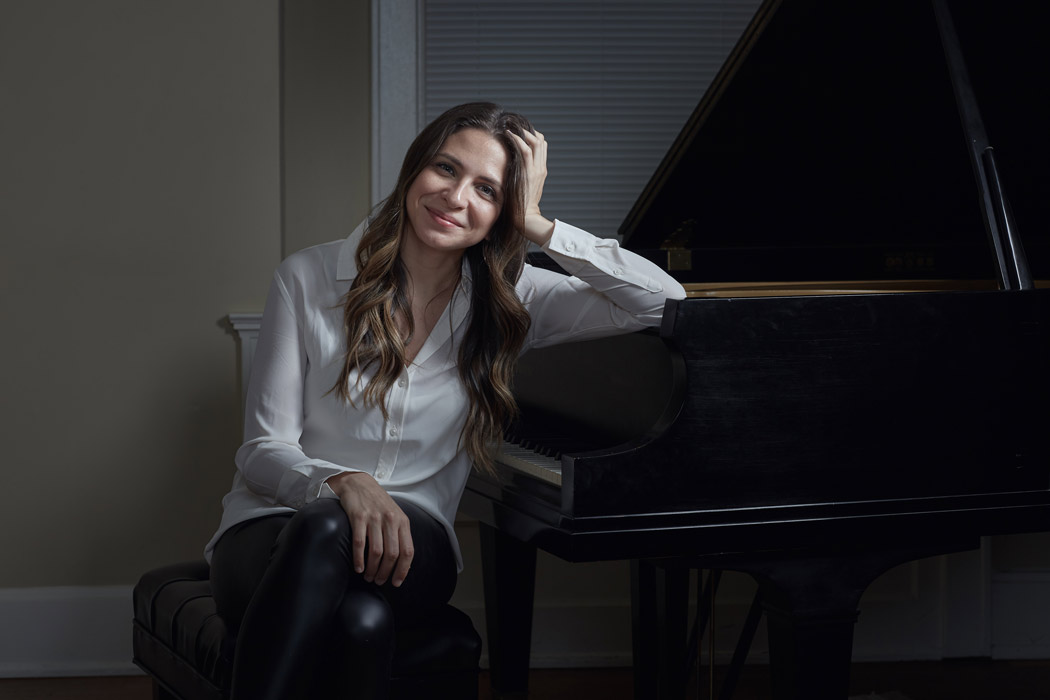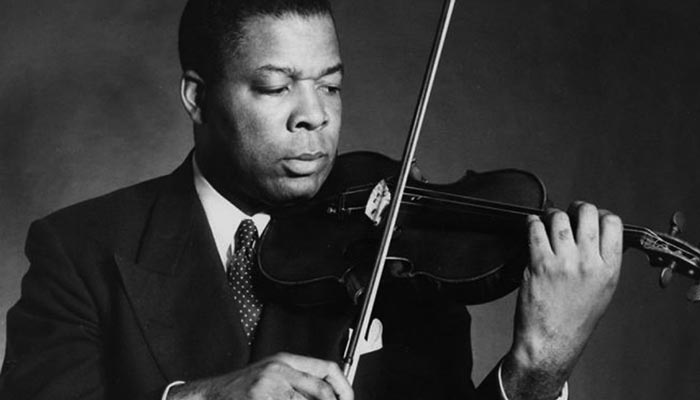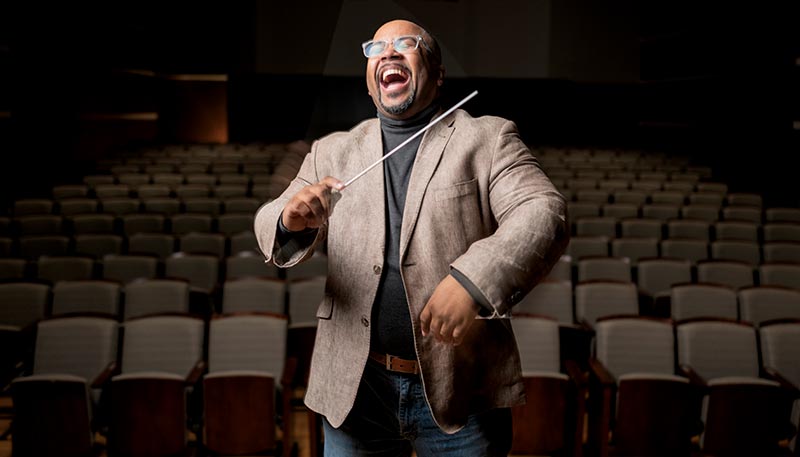Pianist’s tremor shapes her art, inspires advocacy
A neurological condition causes Brianna Matzke’s hands to shake, a reality the KU School of Music alumna explores in a new concert and art exhibition.

Like all professional pianists, Brianna Matzke relies on deliberate, precise movements of her hands and fingers to expertly strike the keys. She has perfected her playing since childhood, each motion ingrained through countless hours of practice.
Movements that she cannot control, however, are also an element of her work.
“I shake all day, every day,” says Matzke, f’09, who in 2020 was diagnosed with essential tremor, a neurological condition that causes shaking in the body, often in the hands, as it does for Matzke. “I don’t know how to exist in a body that doesn’t have essential tremor, so if I woke up tomorrow and the shaking in my hands was gone and I tried to sit down and play the piano, I would probably have to relearn my approach. My artistry is the shaking—it’s an inherent part of it.”
Piano has been part of Matzke’s life as far back as she can remember. Her mother taught high school band and owned a piano, and Matzke, who grew up in Minnesota, fast developed a fondness. “Piano has always been my safe place,” she says. “If I’m having a bad day or need to work out my emotions, I go sit in front of the piano, and it helps me work through things and feel better.”
When Matzke was ready to apply to colleges, a mentor who was a professional pianist put KU’s School of Music on the young artist’s radar. On Mount Oread, Matzke joined the University’s Contemporary Ensemble, directed by Forrest Pierce, professor of composition, who found Matzke’s talent transcended just hitting all the right notes.
“There’s a kind of soulfulness about Brianna’s playing that’s not present in everyone,” Pierce says. “There was something solid all the way to the core about the way she approached making music, and there still is. She’s a very special musician, and it’s something on the inside, not just her fast and fancy fingers.”
After graduating with her degree in piano performance, Matzke pursued her master’s and doctorate at the University of Cincinnati, which is when a shaking in her hands first became apparent. “I didn’t notice it—other people did,” says Matzke, who shared a campus office with fellow graduate teaching assistants. “They would remark from time to time, ‘Brianna, are you OK? Your hands are shaking.’ I just thought I’d had too much coffee or didn’t sleep enough.”
She didn’t know whether she should be concerned about her persistent trembling—or whether it was affecting her work. “It’s really hard, when you’re experiencing the nerves that come along with a performance, to distinguish what are normal nerves and what isn’t normal,” Matzke says. “It was hard to tell if I missed a note because I just didn’t practice enough or some other human error was at play, or if my body was truly out of my control.”
Doctors gradually ruled out other possible causes of the shaking and referred Matzke to a neurologist, who diagnosed her with essential tremor, which can apply to involuntary shaking in different parts of the body, such as the head, voice and legs. According to the International Essential Tremor Foundation, the condition affects an estimated 7 to 10 million Americans and has no known cure.
“For some people, it’s extremely debilitating. For me, it’s mild,” Matzke says. “Putting on eyeliner or mascara is challenging. I don’t always have the neatest handwriting. Eating soup in public on certain days doesn’t go very well. But other than that, there’s very little stress. Most people who have essential tremor describe the worst parts of it, other than difficulties with the shaking, as the feeling of embarrassment or being misunderstood, because there’s a lot of stigma associated with someone who is shaking.”
Tense muscles tend to exacerbate shaking from essential tremor, so given that proper piano technique minimizes tension in the hands, Matzke says her shaking does not hinder her playing. Yet working in the world of classical music, which prizes perfection, Matzke worried that negative perceptions of her shaking could harm her career as a professor and avid performer (she is an associate professor of music at Wilmington College in Ohio). She ultimately decided to share her diagnosis so she could control the narrative and, she hoped, use her art to foster understanding and connection.
Early in her career, Matzke developed “The Response Project,” which commissions artists of diverse disciplines—musicians, dancers, sculptors, painters, poets and others—to create works around a given theme. For her latest installment, she invited artists to respond to essential tremor and their personal experiences with matters of ability and disability.
“Tremor,” a concert and art exhibition, debuted in May at the American Sign Museum in Cincinnati. Matzke, who is on sabbatical, has taken the project on the road this fall, performing throughout the Midwest and eastern U.S.
Among the artists featured in “Tremor” is Pierce, who composed the piano solo “Something, Shimmering” for Matzke.
“It’s not that Brianna is the only pianist who can play it,” Pierce says. “But she’s the only pianist I know of whose natural physical embodiment already automatically produces some of the movements.”
The piece employs a tool Pierce devised called the “Shimmermitten,” a stainless steel glove with dangling silver, leaf-shaped charms. At the end of the piece, Matzke dons the Shimmermitten and, over the upper strings of the piano, extends her hand to exaggerate her shaking. The action makes the mitten sing against the vibrating strings.
“One of the things that’s really special about the project, as it developed, was to see how flexible and humble Brianna was in approaching the subject of disability, recognizing that it takes a huge variety of forms in human bodies and minds,” Pierce says.
For Matzke, who partnered with the International Essential Tremor Foundation on “Tremor,” the opportunity to contribute to advocacy has been particularly rewarding. She has received messages from people around the world who have essential tremor, many of whom are not public about their diagnosis, thanking her for increasing awareness of the condition.
“That really makes this so worth it for me,” Matzke says. “To know that sharing this part of myself is helping other people feel safer or more seen or understood in some way.”
Megan Hirt, c’08, j’08, is associate digital editor for Kansas Alumni magazine.
Photo by Ryan Back
/




